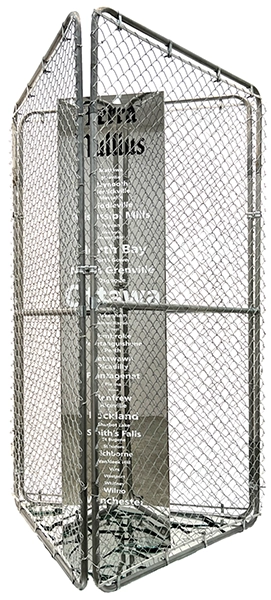
10 Flint Avenue, P.O. Box 398, Bancroft, Ontario K0L 1C0 Phone 613-332-1542 email: artgalleryofbancroft@gmail.ca
Proudly supported by:


“A Land Acknowledgement”
102″ x 60″ x 60″ x 60″
Metal, vinyl, acrylic and paper
A Land Acknowledgement grapples with the devastating realities of our collective past and present. Perhaps the first thing you notice is the fencing. With no gate, no entry or egress, it represents the geographic and socio-economic barriers imposed on Indigenous people, and their separation from the non-Indigenous population. Until we settlers implement meaningful forms of Reconciliation, these barriers remain in place.
The central tower of mirror-finish steel has text applied. On two sides are listed the place names of colonial settlements. The text size used for these names varies to accord with the population size of each settlement.
The third side is reserved for tiny Pikwakanagan, the sole remaining Algonquin-founded, Algonquin-majority, community within their vast, unceded territory. Not seen here are the ghost Algonquin communities of Antoine, Bancroft, Bonnechere, Greater Golden Lake, Mattawa, Ottawa, Shabot Obaadjiwan, Snimikobi and Whitney.
Larger text across the top of each side of the tower refers respectively to the Doctrine of Discovery, Terra Nullius, and Manifest Destiny, all of which mandated colonial encroachment on and annexation of Indigenous lands.
Looking through the fence you see your own fenced reflection in the mirrored surface of the tower. Look down – the shattered mirror covering the floor speaks of shattered lives and generational trauma, as the images reflected on the tower are reflected there, infinitely broken, and distorted.
Imagine yourself in restricted confinement and contemplate how it might feel to live within the constraints of those barriers.
What Can I Do? I’m Just One Person …
True Reconciliation begins with empathy and intention.
If you want to make a difference, start — listen. Read. Inform yourself.
Be an ally. Call out anti-Indigenous sentiment in all its forms, wherever you encounter it.
Listen to their stories. Learn their history. Understand the validity of Indigenous ways of being in the world and of their relationship with the land.
Support Indigenous-led businesses. Support politicians who prioritize working to change the current system.
Create a better future for all of us by encouraging the creation of opportunities for Indigenous youth in education, the arts and in business.
Reconciliation is a moving target. It will never be “one and done,” but it can begin with small, heartfelt steps. The important thing is to begin.
You can take a very small step toward Reconciliation today by choosing an “Intention” from the tray attached to the fencing. Hang it from the fence while considering how you can bring this intention into your life.
From the second tray, please choose and keep the question or intention that resonates most with you, as a reminder that even small steps toward reconciliation are meaningful.
(Artist, dog-mom, political junkie)
I have been living and working in rural Ontario since graduating OCA(D) with honours (fine art drawing and painting,1991). Since 2021 I have been Curator at the Art Gallery of Bancroft. Currently I am also Chair of the gallery’s Board of Directors.
An Anglo-Québecoise and the daughter of holocaust survivors, I see art as activism, a means of communicating important ideas with the goal of effecting change.
A visual artist whose primary focus in recent years has been abstraction, my work embraces whatever is required for the concept, including large, multifaceted installations. I feel an urgent need to make art that responds to and reflects the tumultuous socio-political issues of our time.
Over the past 30+ years my artistic practice has explored such diverse themes as democracy and international politics (The Democracy Project, Art Gallery of Peterborough, 2004), the AIDS pandemic (Impact Aids, Rebecca Gallery, 2006), familial relationships, and always, the abstract nature of our universe.

10 Flint Avenue, P.O. Box 398, Bancroft, Ontario K0L 1C0 Phone 613-332-1542 email: artgalleryofbancroft@gmail.ca
Proudly supported by:

Charitable Registration #: 81973 7750 RR0001
The Art Gallery of Bancroft is situated on the traditional territory of the Anishinaabeg Algonquins, which is known to be unceded. Indigenous people have been stewards of this land since time immemorial; as such we honour and respect their connection to the land, its plants, animals and stories. Our recognition of the contributions and historic importance of Indigenous peoples is sincerely aligned to our collective commitment to make the promise and the challenge of truth and reconciliation real in our community.